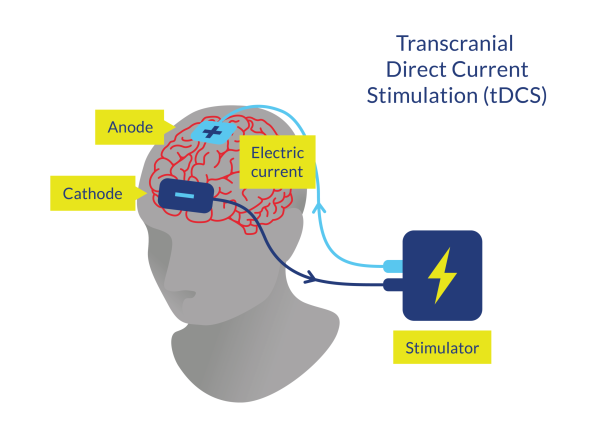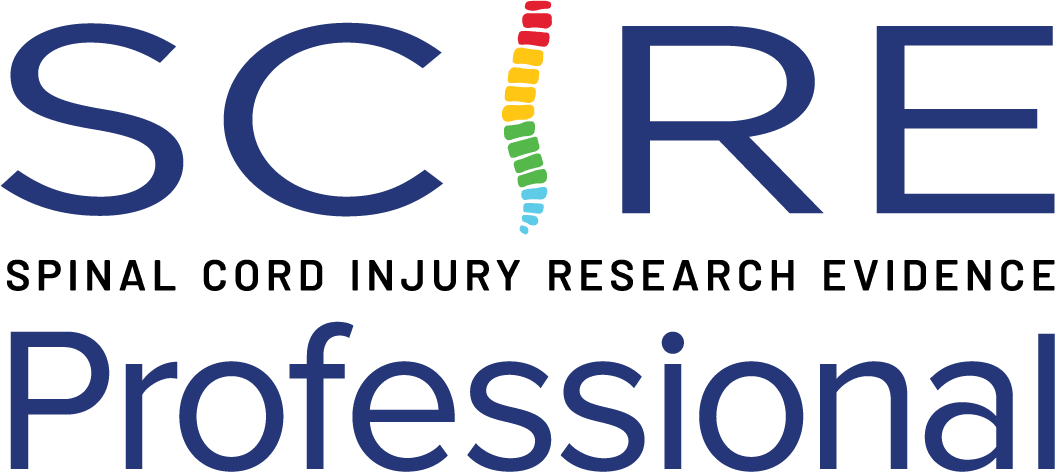Transcranial Direct Current Stimulation (tDCS)
Transcranial direct current stimulation (tDCS) is increasingly used in rehabilitation research as a neuromodulatory approach to influence the excitability of cortical and cerebellar networks (Evans et al. 2022). The aim is often to “prime” neural circuits to increase corticospinal activation and to augment effects of MST (Evans et al. 2022). The majority of the studies published on the combination of tDCS and motor rehabilitation is related to upper limb, and studies examining the effects of tDCS on lower limb motor learning in persons with motor-incomplete SCI are still sparse (Kumru et al. 2016b).

Figure 8. Transcranial Direct Current Stimulation (tDCS)
Discussion
Two high-quality studies (Evans et al. 2022; Evans & Field-Fote 2022) found that locomotor-related MST, with and without tDCS, provided significant increases in overground walking speed (10MWT), walking distance (2MWT), cadence, and bilateral stride length, but the addition of tDCS was not associated with greater improvements compared with the sham application. Another high-quality RCT (Klamruen et al. 2024) found that both anodal tDCS and sham tDCS groups showed similar significant improvements in gait kinematics (stride length, stride duration, and cadence), lower extremity strength (FTSTS test), and self-selected speed (10MWT); however, higher improvements were observed in the experimental group for walking speed (10MWT) (Klamruen et al. 2024). Similarly, other studies, such as the RCT by Nijhawan and Kataria (2024), had shown similar significant improvements in LEMS after an active or sham tDCS application for five sessions per week over two weeks (plus conventional rehabilitation) in participants with chronic SCI.
The combination of gait training with tDCS in patients with neurological disorders has been systematically reviewed by Hernández de Paz et al. (2019), but only two reports included patients with SCI (Kumru et al. 2016b; Raithatha et al. 2016), while the others studied patients with stroke or Parkinson’s disease. Three high-quality studies assessed the effects of the combination of tDCS and BWSTT in patients with motor-incomplete SCI, one of them in an acute–subacute phase (Kumru et al. 2016b), and two in a chronic phase (Simis et al. 2021; Raithatha et al. 2016). Kumru et al. (2016b) included patients with a mean time since injury of 4.1 months who received standard care for SCI rehabilitation and 20-min tDCS sessions during BWSTT with Lokomat, 5 days per week, 30 min per day. Patients were randomly allocated to the anodal tDCS or sham application of tDCS group (Kumru et al. 2016b). After 4 weeks of intervention and 4 weeks of follow-up, both groups significantly improved in lower extremity motor strength (LEMS) and gait function (10MWT and WISCI II), but without significant differences between the tDCS and the sham application (Kumru et al. 2016b). In the RCT of Simis et al. (2021), patients with chronic SCI, participants received 20 min of active or sham tDCS immediately before BWSTT with Lokomat for 30 min. After 30 sessions, there was a statistically significant difference in the percentage of participants that improved in WISCI II (33% in the sham group vs. 70% in the active group) and in the follow-up; however, other outcome measures related to walking (10MWT and 6MWT) improved significantly across participants, without statistical differences between groups after 30 sessions or after 3 months of follow-up (Simis et al. 2021). Similarly, Simis et al. (2020) aimed to investigate electroencephalography beta oscillations in the sensorimotor area as a novel biomarker for gait function and response to the same treatment as Simis et al. (2021). The results suggested that beta oscillations could be used as a diagnostic, predictive, and surrogate biomarker in SCI for gait function (Simis et al. 2020). These findings have great rehabilitative potential for patients with SCI, as they can help design therapy based on consistent predictors of positive responses to gait training and tDCS (Simis et al. 2020). Moreover, it can support the decision about the number of sessions and the adequate moment of discharge based on a surrogate outcome, making therapy more cost-effective (Simis et al. 2020). Lastly, the study of Raithatha et al. (2016) was the very first to evaluate the effects of combining tDCS with LT to facilitate gait recovery for people with incomplete and chronic SCI. Patients were randomly allocated into two groups: 20 min of tDCS (active or sham) immediately before LT with Lokomat (Raithatha et al. 2016). While both groups showed improvement in motor function after 12 weeks of intervention and at long-term follow-up, the active tDCS group showed more improvement in MMT than the sham tDCS group (Raithatha et al. 2016). Walking outcomes (6MWT and 10MWT) results were contradictory, as within-group changes from baseline to 1-month follow-up indicated significant improvement on 10MWT and 6MWT only for the active tDCS group, while between-group comparison of changes from baseline to post-intervention revealed that the sham tDCS group improved significantly more than the active tDCS group on 6MWT (Raithatha et al. 2016).
It should be noted that tDCS seems to be a feasible and safe intervention. Studies of Klamruen et al. (2024), Kumru et al. (2016b), Raithatha et al. (2016), and Simis et al. (2021) stated that all patients tolerated the intervention with no complications; and only Evans et al. (2022) and Evans and Field-Fote (2022) found that four participants in the active tDCS group (n = 14) had mild-to-moderate poststimulation headache related to the tDCS intervention (but it was not stated if the AE occurred in the active or the sham group).
Conclusions
There is level 1 evidence (from 2 RCTs: Evans et al. 2022; Evans & Field-Fote 2022) that a brief intensive MST involving a circuit of ballistic, cyclic locomotor-related skill activities improved overground walking speed (10MWT), walking distance (2MWT), cadence, and bilateral stride length; however, concurrent application of tDCS did not further enhance the effects of MST in patients with motor-incomplete SCI.
There is level 1 evidence (from 1 RCT: Klamruen et al. 2024) that anodal or sham tDCS in a sitting position prior to OGT at moderate intensity for five days provide similar improvements in gait kinematics (stride length, stride duration, and cadence), lower extremity strength (FTSTS test), and self-selected speed (10MWT); but higher improvements in walking speed (10MWT) for the anodal tDCS, in patients with incomplete and chronic SCI.
There is level 1 evidence (from 1 RCT: Kumru et al. 2016b) that 4 weeks of BWSTT with Lokomat and standard care improved lower extremity motor strength (LEMS) and gait function (10MWT and WISCI II); however, concurrent application of tDCS did not further enhance the effects of BWSTT in patients with motor-incomplete and acute SCI.
There is level 1 evidence (from 2 RCTs: Simis et al. 2021; Raithatha et al. 2016) that the application of tDCS immediately before BWSTT with Lokomat significantly improved more the walking ability (WISCI II) and lower extremity motor function (MMT), and similarly the walking speed (10MWT) and walking distance (6MWT) compared to the same intervention but with a sham stimulation in patients with motor-incomplete and chronic SCI.
